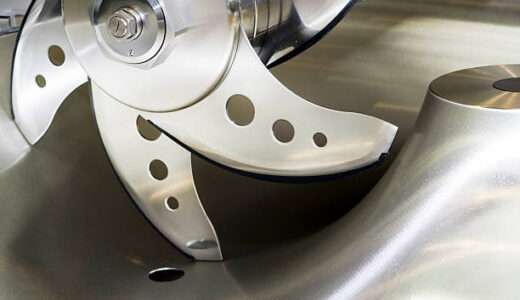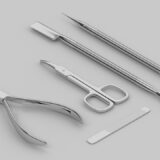
Stainless industrial blades are specialized cutting tools made from stainless steel for various industrial applications. Stainless Steels for knives are often introduced by Knife hobbyists, while stainless steel industrial blade information is rarely available. In this article, the author, who has 13 years of experience in procuring metal parts and materials for Toyota Motor Corporation and startup companies, will introduce the following with my experiences. we introduce stainless steel materials for industrial blades and compare among them. Lastly, we introduce a brand new blade stainless steel currently under evaluation among Japanese blade manufactures.
There are many types of special steels for industrial blades; Super steel, Powdered HSS (High Speed Steel), HSS, Dies steel, Carbon tool steel, and Stainless steel. For blade application, martensitic stainless steel is the type of stainless steel used because of hardenability after heat treatment (quenching & tempering) process. Martensitic stainless steel blades have the following characteristics and mainly used for food processing industry.
- Corrosion Resistance: Stainless steel blades are highly resistant to corrosion and oxidation, making them suitable for use in environments where exposure to moisture, chemicals, or other corrosive substances is common.
- Durability and Strength: Stainless steel is a strong and tough material, allowing these blades to withstand heavy-duty cutting tasks without easily succumbing to wear and tear (less tipping / nicks / breaks).
- Hygiene and Cleanness: Stainless steel is easy to clean and sterilize, without protective coating. Stainless steel is chemically neutral, thus flavor does not transfer one cutting object to another. In industries like food processing and medical equipment manufacturing, stainless steel’s hygienic properties are crucial.
- Reduced Maintenance: Due to their corrosion resistance and durability, stainless industrial blades require less frequent sharpening or replacement, reducing maintenance costs.
- Relatively low materials cost: Among the steel types for blades, stainless steel is the second lowest cost after carbon tool steel.
- Hardness : Among special steels, stainless steel is relatively less hard. Stainless steel is accepted for cutting softer material such as food.
Stainless steel is the softest material among special steel blades. For your reference, below is the table of hardness and heat treatment conditions to achieve the hardness for your reference. This table indicates that depending on the steel grade and heat treatment conditions, stainless steel’s hardness is not so bad. It can exceed Dies steel and reach close to Carbon tool steel.
| Steel Type | Hardness (HRC) | Heat Treatment (℃) |
|---|---|---|
| Super Steel | 90~92 | Unnecessary |
| Powdered HSS | 63~66 | Quenching : 1200℃, Tempering : 500℃ |
| HSS | 64 | Quenching : 1200℃, Tempering : 500℃ |
| Dies steel | 55~65 | Quenching : 1050℃, Tempering : 200 or 500℃ |
| Carbon Tool steel | 63 | Quenching : 850℃, Tempering : 200℃ |
| Stainless steel | 50~60 | Quenching : 1000℃, Tempering : 200℃ |
There are several points to consider for selecting Stainless Steel for Industrial Blades.
Hardness is a material’s resistance to deformation under load, affecting wear resistance and sharpness. We can measure hardness by testing methods like Rockwell, Brinell, Vickers, and Knoop. Meanwhile, toughness enables repeated cuts without deformation or fracture, in other words, cutting edge retention and durability. We can measure toughness by tensile and impact tests. As industrial blades numerously repeat cuttings, toughness is an important factor for business operation. The relationship between hardness and toughness is often inversely related, since the amount of carbon affects to increase hardness but decrease toughness. Steel mills create hybrid Stainless steels and coatings to balance both properties. We would like to remark kindly that the coatings for food application are usually not be acceptable because coatings are like “make ups” so that coatings may peel off after numerous cutting works.
The Stainless steel’s quality (stableness for processing) is an essential element to select stainless steel material. There are several points to consider for the material and supplier,
- Tolerance Control: Tolerance is an important factor to process stably every time. For example, even if you say thickness of 0.6mm or 0.024″, actually physical thickness cannot be always 0.6mm. Thus, tolerance is set such as 0.6mm ± 0.05mm etc. This is important to perform consistent hardness after heat treatment (quenching and tempering).
- Rust Control: Even though stainless steels are corrosion resistant or difficult to rust, the stainless steels rust. From steel material preparation point of view, rust may happen if degreasing process is inadequate, anti rust oil/paper is improperly applied, or humidity control between steel processing and storage is not appropriate.
- Stableness of Hardness after quenching and tempering: Even if you obtain satisfactory hardness from a sample, it will be ruined if the commercial, large volume stainless steel does not achieve the same hardness. You wish to achieve the same hardness from the same quenching and tempering conditions every time. This lack of stable hardness happens when the impurities inside the stainless steel is not removed enough or remain in clumps at certain points, or carbides (small particles of carbon) are not equally small and distributed inside the stainless steels.
- Chipping: Chipping is caused when a carbide (small particles of carbon) is taken off from a stainless steel. Chipping is inevitable because stainless steels contain carbons. However, the scale and risk of tipping can be reduced if the carbides are equally small and distributed inside stainless steels.
If blades are your hobby, each individual is free to spend as much money as he/she likes. Meanwhile, if blades are part of your business, you may consider cost and performance of a blade. If blade material is more costly yet, it has longer life, it may pay off after using a month or a year.
Even if the blade material cost is low, if you need to change every 2 hours of operation, it requires huge amount of time and operator’s cost to replace blades. Besides, industrial blades are often resharpened after some usage. If the Stainless steel contains less carbon, it is easier to grind. Thus, when considering the material, easiness of maintenance is a point to consider.
There are several different stainless steel grades for industrial blades. Some are internationally well recognized while others are more used locally.
| Steel Grade | Location | Hardness (HRC) | Carbon Content | Chromium Content | Comment |
|---|---|---|---|---|---|
| 410/X12Cr13/1.4006 | All | 45 | ~0.2% | 11.5~13.5% | This steel grade has good corrosion resistance and machinability. |
| 420/X30Cr13/420J2/1.4028 | All | 52 | 0.3~0.4% | 12.0~14.0% | The most popular steel grade for blades. It has great accessibility (Cost, Delivery, Quality) and machinability (easiness to process). |
| 440A | All | 54 | 0.6~0.8% | 16.0~18.0% | popular steel grade for industrial blades. |
| 440C | All | 58 | 1.0~1.2% | 16.0~18.0% | Another popular steel grade for industrial blades. One of the hardest stainless steels for industrial blades. |
| 1.4034 | Europe | 58 | 0.5% | 13.7% | Famous stainless steel for professional kitchen knives. |
| 1.4122 | Europe | 55 | 0.4% | 16.1% | corrosion-resistant martensitic stainless steel |
| AUS6 | Japan | 54 | 0.6% | 13.8% | Often circulated as kitchen knives and industrial blades in Japan. Available in plate form. |
| AUS8 | Japan | 58 | 0.8% | 13.8% | Often circulated as kitchen knives and industrial blades in Japan. Available in plate form. |
| AUS10 | Japan | 60 | 1.0% | 13.8% | Famous stainless steel for professional kitchen knives. Available in plate form. |
| VG10 | Japan | 60 | 1.0% | 15.0% | Famous stainless steel for professional kitchen knives. |
| CB6 | Japan | 58 | 0.6% | 13.8% | New development to solve 420 concerns. Hardness equivalent to 440C. It can be thinner and longer blades due to hardness, offsetting cost increase and improving food processing/design flexibility. Less carbon than 440C makes it rust-resistant and easy to process (can be efficiently grind and resharpened). Less carbon also reduces risk of blade chipping. Available in coil & plate form. |
Industrial blades are often a headache for end users as they are consumable material to replace frequently, yet end users need to take care of the sharpness, avoid contaminations, and keep safety for operators. To reduce frequency of changes, Enserve is positioned to offer unique stainless steel such as CB6 in your required specification (coil, plate, stamped, at annealed or quenched & tempered). CB6 is ready to offer samples and commercialization in relatively short period of time.


